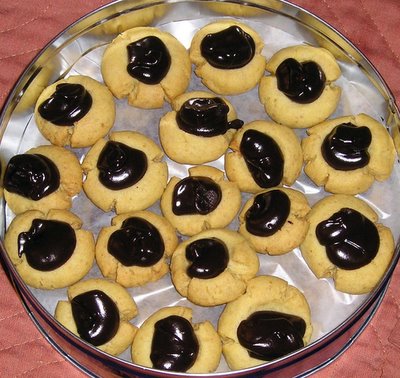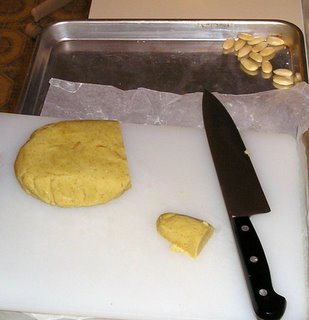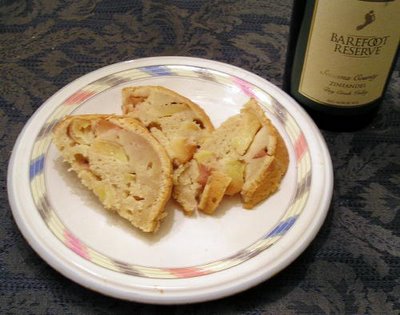Black Cake II

Let's just come right out and state the obvious here. Making a double recipe of black cake is dumb. And it's dumb for multiple reasons. To begin with, a single recipe of black cake already makes two hefty cakes. The recipe says something like two nine-inch cakes, but that's only true if your nine-inch cake pans are also four inches deep. Otherwise, you're really talking about two ten-inch springform pans or perhaps one ten-inch springform pan and one nine-inch springform pan, if you like life on the edge. And a black cake is dense: a ten-inch black cake will give you twenty-five or thirty servings, unless you've starved your guests for a six or eight hours beforehand and serve dessert before the rest of the meal (Which is not necessarily a bad idea, because, really what's more annoying than a guest who shows up at your table with an insufficient appetite? And who can object to dessert first? It's Christmas, for crying out loud.) So with that single recipe, what you'd ideally make would be three eight-inch cakes and perhaps a ramekin-sized cake with the extra batter.
A double recipe also involves a lengthy soaking of ten pounds of dried fruit in 3 liters (total) of wine and rum. It is not easy to find a container big enough to hold all that, and once you've found such a container, it is not easy to convince your territorial partner that your container of macerating fruit deserves space in the pantry for two or three months. This is the sort of disagreement that can lead to your vat-o-fruit making multiple trips up and down the basement stairs (hopefully not under its own power), which hurts the fruit not at all, but is annoying and will, justifiably, make you feel ridiculous.
And then, of course, when you've managed to retrieve your vat-o-fruit from the basement for the last time, while simultaneously carrying up your extremely large metal mixing bowl
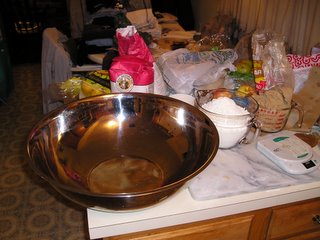 (twenty-four inch diameter, I'm talking here; I'll post pictures, but it's difficult to tell just how big it is because it just makes everything else look smaller), and you've gotten about halfway through the pan preparation that you need to do before you can begin mixing up the batter, your partner is liable to walk through the kitchen and say "Are all of those pans going to fit in the oven at the same time?" and you will realize that they probably will not, and if you then suggest that right now might be a good time to add a second oven, you will be greeted with derision, bemusement, exasperation, anger, or some combination of all of the above.
(twenty-four inch diameter, I'm talking here; I'll post pictures, but it's difficult to tell just how big it is because it just makes everything else look smaller), and you've gotten about halfway through the pan preparation that you need to do before you can begin mixing up the batter, your partner is liable to walk through the kitchen and say "Are all of those pans going to fit in the oven at the same time?" and you will realize that they probably will not, and if you then suggest that right now might be a good time to add a second oven, you will be greeted with derision, bemusement, exasperation, anger, or some combination of all of the above. All of which is to say that if you really need that much black cake (and why wouldn't you?), you can just do everything in two batches instead of one double batch. Two jar-o-fruits, one set of pans, one oven, and two batter preparations, the second of which can be done while the first batch is baking.
I had intended to bake my black cakes on Black Friday, but it's a very good thing that I wasn't actually ready to bake until the next day because, as I may have mentioned (several times) before, my springform pans are missing. I have looked all over the basement, kitchen, and study for them, but I have not found them. When I mentioned this to V. for the third time (he knows enough not to pay attention before then), he said that I was surely mistaken and that he was nearly certain that he'd seen me use the pans in his kitchen and that they must, therefore, be somewhere in the basement, and then he trundled down the stairs (I hope that's an appropriate use of "trundle" because if I were to look it up and find that it wasn't, I'd be entirely heartbroken, so I'm not going to look it up. Ignorance really is bliss.)
to find the missing pans, but he reascended panless. His (and my) failure to find pans meant that I really needed to procure some, a process that I knew would be painful, and I was not disappointed. I went first to the local consignment shop, where I found exactly nothing. Then I went to (oh, the shame) K-Mart, where I found incredibly overpriced springform pans with you-know-who's name on them. I also, however found a deep, non-springform cake pan that was significantly less overpriced (but also with you-know-who's name on it), though it was, sadly, not as much less overpriced at the register as it was on the shelf. But I was, by this time, already a defeated man, and I wasn't going to argue over another dollar or two.
Leaving K-Mart (oh, the shame), I proceeded to the mall, which really was not all that crowded, presumably because all of the hardcore shoppers had exhausted themselves on Friday. I started in Target, where I immediately found a three-pack of springform pans for about half of what I would have spent for one of you-know-who's springform pans over at you-know-where (oh, the shame). Although the pan sizes were not ideal (8.5, 9.5, 10; why, oh why, can you not find a six-inch springform pan these days? Oh, don't ask why. Oh, don't ask why.), I picked them up and left Target at small expense to my wallet, though at an enormous cost to my soul, which I then further abused by going to three different department stores in the same mall in search of something more appropriate. I did not find anything, so I limped home, a broken man.
(I got better.)
What would have worked very well, I think, were some six-inch Pyrex or Corningware pans that I saw in the Hecht Company, but these were, apparently, part of a set, though they were displayed as if they were open stock (with a half-off sign, yet). The next time I am driving by Hagerstown, I will stop at the outlet center, where they almost certainly have a Corning outlet, and I will pick up several of them and then hide them in the basement, preferably in a location that I can actually find again.
Black Cake
1.5 liter Manischewitz Concord Grape Wine
1.5 liter dark rum
2 pounds pitted prunes
1.5 pounds dried pitted tart montmorency cherries
1 pound dried pineapple chunks
2 pounds Thompson seedless raisins
8 oz. organic candied ginger chunks
2 pounds currants
8 oz. candied orange peel
8 oz. dried apricots
2 pounds butter (plus extra for greasing the pans)
2 pounds dark brown sugar
2 T. vanilla extract
2 dozen large eggs
36 ounces flour (plus extra for flouring the pans)
2 T. baking powder
1 t. ground cinnamon
1 t. ground nutmeg
1 c. burnt sugar essence
Several months (or at least a couple of weeks) before you're ready to bake the cake, cut the dried fruits into itty bitty pieces, toss them in a great big jar, and cover them with the spirits.
Allow time to pass. I hear it waits for no man.
On the day that you're going to bake your cakes, set your butter out to come to room temperature, and then get your pans ready. My pans were two four-inch ramekins, one eight-inch Corningware souffle/baking dish, one eight-and-one-half inch springform pan, one nine-inch, extra deep cake pan, one nine-and-one-half inch springform pan, and one ten-inch springform pan**. Butter the pans thoroughly (even though the springform pans are have a non-stick coating) and line the bottoms with circles (cut to fit the pans) of brown paper. If you are wise, you will also line the sides with brown paper, though this is not especially helpful for the ramekins or the souffle dish; otherwise, you may later worry, perhaps needlessly, that the edges of your cakes are slightly overdone. Butter the inside of the brown paper, then flour the pans.
Preheat the oven to 325 degrees.
In the bowl of your Kitchenaid, with the paddle attachment, beat the room temperature butter until it is fluffy. Add the brown sugar and beat until it is well incorporated and again fluffy. Beat in the vanilla extract. Scrape this mixture out into your giant bowl.
Stir together the flour, baking powder, cinnamon, and nutmeg.
Break the eggs into your Kitchenaid bowl and beat them until they are well combined.
Add the macerated fruit mixture to the butter and sugar mixture and stir together as well as you can. Add the flour mixture, the eggs, and the burnt sugar essence to the bowl. If you have not already done so, roll up your sleeves, make sure your hands are clean, plunge them into the bowl, and work the batter around until it's all well mixed.
Fill the pans to a depth of about two inches. Smooth the tops and place in your preheated oven. Bake for an hour to an hour-and-a-half, until they're done.*
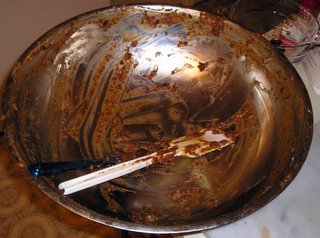 I baked my two ramekin-sized cakes (they're so cute; a friend in California asked me specifically for a "black cupcake," and that was as close as I was willing to get. I'm going to eat the other ramekin-sized cake this weekend, I reckon) in the toaster oven, but I could still only fit four of the five larger cakes in my regular oven at once. I covered the fifth with plastic wrap and put it in the refrigerator for about an hour, then pulled it out to come to room temperature while the first four were finishing baking.
I baked my two ramekin-sized cakes (they're so cute; a friend in California asked me specifically for a "black cupcake," and that was as close as I was willing to get. I'm going to eat the other ramekin-sized cake this weekend, I reckon) in the toaster oven, but I could still only fit four of the five larger cakes in my regular oven at once. I covered the fifth with plastic wrap and put it in the refrigerator for about an hour, then pulled it out to come to room temperature while the first four were finishing baking. I moved the cakes around every twenty minutes. I started out with cakes on the left rear and right front of the upper rack and on the left front and right rear of the lower rack. After twenty minutes, I moved the front cakes back and the rear cakes forward. After forty minutes, I moved the bottom cakes to the top and the top cakes to the bottom and changed front to back so that the layout was the same as when I'd started, though the cakes in each position were different. After sixty minutes, I moved the front cakes back and the rear cakes forward again. This probably slowed the baking significantly, but this is not a delicate cake that will fall if it doesn't sit in an unopened oven for the entire baking time, and when your oven is crowded, if you don't move things around, you're likely to get uneven baking.
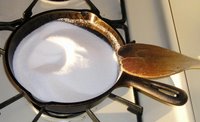
 If you can't find burnt sugar essence (and you can't), get out your cast iron skillet and put a cup of white sugar in it and place it over medium heat. Stir it more or less constantly with a wooden spoon until it melts and then darkens. When it is very brown and has begun to bubble profusely, turn the heat off, and -- quickly but carefully -- add a half cup of cold water to it. You should probably wear an oven mitt for this last step, which is somewhat frightening. When it stops acting like an angry llama (don't ask me; ask Mimi Smartypants), stir it well with a wooden spoon. You should have about a cup of something that, I am told, is very like burnt sugar essence.
If you can't find burnt sugar essence (and you can't), get out your cast iron skillet and put a cup of white sugar in it and place it over medium heat. Stir it more or less constantly with a wooden spoon until it melts and then darkens. When it is very brown and has begun to bubble profusely, turn the heat off, and -- quickly but carefully -- add a half cup of cold water to it. You should probably wear an oven mitt for this last step, which is somewhat frightening. When it stops acting like an angry llama (don't ask me; ask Mimi Smartypants), stir it well with a wooden spoon. You should have about a cup of something that, I am told, is very like burnt sugar essence. You will want to avoid making the burnt sugar essence in your six-inch iron skillet because if you do, when the caramel gets to the profuse bubbling stage, it will overflow the skillet and make quite a sticky mess on your oven top by the time you have turned off the heat and poured in the water, and then you will have to clean it up. Caramel might even get down inside the stove top, underneath the cooking surface, but if you're fortunate enough to know that your very old range is about to be replaced (rather than added to, alas) with a brand new range the following week, then you can get away with only cleaning the surface. Not that anything like that has ever happened to me, you understand.
When you think the cakes are done (and, alas, there will be some uncertainty; you just have to do your best and take them out when they feel relatively firm when you press on the top and when the toothpick comes out without crumbs on it), remove them from the oven and set them on racks to cool. When the pans are cool enough to handle, remove the outside of the springform pans, and unmold any non-springform pans. Do not remove the brown paper from the bottom of the cake. Put them back on the racks to cool entirely, then wrap in aluminum foil.
I have not yet gotten to the point of shipping any of the cakes, but now that they've been out for a few days, I will wrap them in rum-soaked cloths before rewrapping them in aluminum foil. Black cake needs to be frosted, and I'll post about the frosting in another post. You don't frost them until you're about ready to eat them, though, and in any case they can only be shipped in their unfrosted state. I am certain that any of the people I'm sending them to can handle the frosting and decorating.
* Determining exactly when a black cake is done is not, alas, an easy task. I was simultaneously convinced that they were overcooked and undercooked. I did eventually convince myself that they weren't raw on the inside, but even after cooling for many hours or overnight before wrapping, the cakes threw off a significant amount of moisture during the first couple of days they were wrapped in the aluminum foil. I think that the best way to deal with this phenomenon is to treat them as if they were regular fruit cakes, which they sort of are anyway, and to sprinkle them liberally with rum and wrap them in a layer of cloth taken from old cotton bedding (this also allows me to tell V. that I have a very good reason for not throwing things away even when I don't have an immediate use for them; though, of course, it also allows him to ask me why I'm washing bedding that is no longer useful) before rewrapping in foil. At least I know they won't be dry. Perhaps before next autumn, I will be able to find some guidance on the internal temperature at which a black cake is optimally cooked. I'm sure Alton Brown knows.
** Because both the area and the volume (assuming a constant depth) of a cake are directly proportional to the square of the cake's diameter (or indeed the square of its radius, the area of a circle being πr2 or (πd2)/4), you can evaluate the relative amount of cake batter that pans will hold by considering the squares of their diameters. This calculation will, for example, tell you that three eight-inch pans will hold slightly less batter than two ten-inch pans of the same depth because 3x82 < 2x102. Using this methodology, I can report that for evaluation purposes, if I were to put a double recipe of black cake into four ten-inch springform pans, I would have 400 units of cake volume (where, to be horribly pedantic and dull, [I will occasionally opine that "dull pedantry" is an oxymoron, but when I say that, I am generally just being a wag] a unit is the height of the cake multiplied by one-fourth of pi and would be expressed in cubic inches, or at least that's my story, and I'm sticking to it). A somewhat, but not very, rough calculation of the cake pans I used indicates that I ended up with 439 units, which means that either the height was not constant (which it wasn't, I'm sure) or the average height was less than I've used in the past, or I somehow ended up with more batter than I have before, or some combination of the three. I have always believed in full geometric disclosure.

